|
Printables |
PowerPoints |
Online exercises |
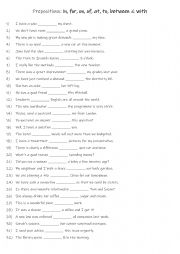
|
A2-B1 Prepositions in, for, on, of, at, to, between & with
Students first familiarise themselves with the the prepositions in bold and their usage.Then they read the sentences to see which preposition is required to complete the gap-fill.Each preposition is used 4 times. Answers on page 2.
Level: elementary
Age: 9-100
Type:
Downloads: 123
|
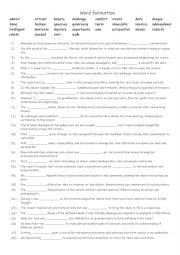
|
B1+-B2 Word formation 7 types of word formation!
Students need to familiarise themselves with all of the words in bold. Then they read the sentences to see which word in bold needs to complete the gap-fill. Then they change the word into the correct form. There are 7 types of word formation:Noun to Adjective, Verb to Adjective, Noun to Verb,Verb to Noun, Adjective to Noun, Adjective to Adverb & N...
Level: intermediate
Age: 10-100
Type:
Downloads: 123
|
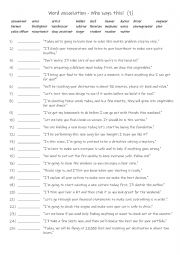
|
A2-B1 Word association with jobs -Who says this! (1)
Learning vocabulary for professions like accountant, chef, teacher, and nurse is valuable because it helps people identify roles, understand career-specific responsibilities, and communicate effectively in different situations. Recognising job titles and what each profession involves supports clearer communication in daily life and improves underst...
Level: elementary
Age: 8-100
Type:
Downloads: 123
|
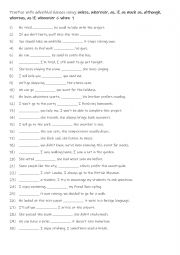
|
A2+-B1 10 adverbial clauses 1
Learning adverbial clauses using words like unless, wherever, as, if, as much as, although, whereas, as if, whenever and when helps students express complex relationships between ideas, such as condition, time, contrast, and manner. These clauses enrich their communication by allowing them to create detailed and nuanced sentences. Mastering these s...
Level: intermediate
Age: 9-100
Type:
Downloads: 123
|
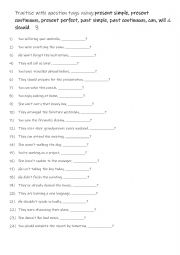
|
A2+-B1 Practise with question tags using present simple, present continuous, present perfect, past simple, past continuous, can, will & should. 3
Students familiarise themselves with the tenses and modal verbs, then they read the sentences to work out which one is needed to complete the gap-fill. Answers on page 2.
Level: intermediate
Age: 9-100
Type:
Downloads: 123
|
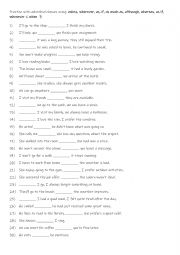
|
A2+-B1 10 Adverbial clauses 3
Learning adverbial clauses using words like unless, wherever, as, if, as much as, although, whereas, as if, whenever and when helps students express complex relationships between ideas, such as condition, time, contrast, and manner. First, students need to familiarise themselves with the 10 adverbial clauses and their use. Then they read the senten...
Level: intermediate
Age: 10-100
Type:
Downloads: 123
|
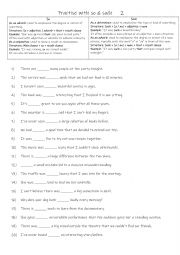
|
A2+-B1 Practise with so & such 2
Learning to use them correctly allows students to enhance descriptions, convey stronger emotions, and sound more natural in both spoken and written English. First, students need to familiarise themselves with the 2 words. Then they read the sentences to work out which one is needed to complete the gap-fill. Each word is used 10 times! Answers on pa...
Level: elementary
Age: 8-100
Type:
Downloads: 123
|
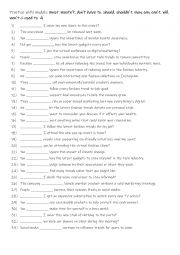
|
A1+-A2 Practise with modals must, mustn�t, don�t have to, should, shouldn�t, may, can, can�t, will, won�t & used to 4
First, students need to familiarise themselves with the modals and their use. Then they read the sentences to see which one is needed to complete the sentence. Answers on page 2.
Level: elementary
Age: 8-100
Type:
Downloads: 123
|
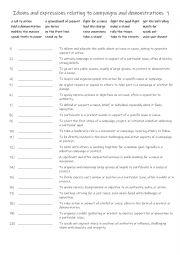
|
B1+-C1 Idioms and expressions relating to campaigns and demonstrations 1
First, students need to familiarise themselves with the 20 idioms and expressions and their meanings. Then they read the definitions to see which one is being described and write that word in the space provided Answers on page 2.
Level: intermediate
Age: 12-100
Type:
Downloads: 123
|
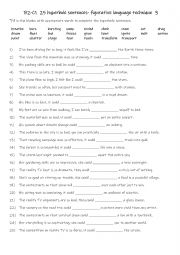
|
B2-C1 25 hyperbole sentences- figurative language technique 3
Recognising and using hyperbole sharpens analytical thinking, as students learn to interpret exaggerated expressions in context. Overall, mastering this figurative language technique makes both written and spoken communication more compelling and expressive. First, students need to familiarise themselves with the 25 words and their meaning. Then th...
Level: advanced
Age: 15-100
Type:
Downloads: 123
|
|
|
|
|












